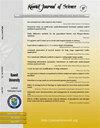Green synthesis and characterisation of silver nanoparticles (AgNPs) from Rubus sanctus schreber leaf aqueous extract and evaluation of their antibacterial and cytotoxic activities
IF 1.1
4区 综合性期刊
Q3 MULTIDISCIPLINARY SCIENCES
引用次数: 0
Abstract
The current study optimised the numerous experimental parameters required for the generation and stability of silver nanoparticles (AgNPs) by the green synthesis of AgNP utilizing aqueous Rubus sanctus leaf extract. By employing UV–visible analysis to find the surface plasmon resonance band at 436.5 nm, the creation of nanoparticles was verified. Based on the Fourier transform infrared spectroscopy (FT-IR), the phytochemical components present in the leaf extract of Rubus sanctus significantly impacted the synthesis of AgNPs as a bio-reducing agent. The shape, size, and elemental composition of AgNPs were examined using X-ray diffraction (XRD), energy dispersive X-ray (EDX), scanning electron microscope (SEM), and transmission electron microscope (TEM), and the results showed that the particles were crystalline, spherical silver nanoparticles. Additionally, AgNPs' inhibitory effects on the growth of pathogenic Staphylococcus aureus, Bacillus subtilis, Escherichia coli, Pseudomonas aeruginosa bacteria, and Candida albicans yeast were evaluated using the microdilution technique. The results showed that nanoparticles worked even at low concentrations. To test the cytotoxicity of biosynthesised AgNPs, three cancer cell lines, the prostate (LnCap), breast (MDA-MB231), and colon (Caco2), as well as a healthy human embryonic kidney (HEK293) cell line, were used. At high dosages, it was observed that Rubus sanctus-AgNPs had potent cytotoxic activity on the cancer cell lines LnCap, MDA-MB231, and Caco2, but their cytotoxicity was less on the control HEK293 cell line. From the data, it can be inferred that biogenic AgNPs were functionalised, and these compounds demonstrated significant potential as antibacterial and anti-cancer agents for industrial and medical applications.
山楂叶水提物纳米银的绿色合成、表征及其抗菌和细胞毒活性评价
目前的研究优化了银纳米颗粒(AgNPs)的生成和稳定性所需的众多实验参数,通过绿色合成AgNP,利用含水的山楂叶提取物。通过紫外-可见分析,在436.5 nm处找到了表面等离子体共振带,验证了纳米颗粒的产生。傅里叶变换红外光谱(FT-IR)研究表明,山楂叶提取物中存在的植物化学成分显著影响AgNPs的合成。利用x射线衍射(XRD)、能量色散x射线(EDX)、扫描电子显微镜(SEM)和透射电子显微镜(TEM)对AgNPs的形状、大小和元素组成进行了表征,结果表明,AgNPs为结晶球状银纳米颗粒。此外,采用微量稀释技术评价AgNPs对致病性金黄色葡萄球菌、枯草芽孢杆菌、大肠杆菌、铜绿假单胞菌和白色念珠菌酵母生长的抑制作用。结果表明,纳米颗粒即使在低浓度下也能起作用。为了测试生物合成AgNPs的细胞毒性,使用了三种癌细胞系,前列腺(LnCap),乳腺(MDA-MB231)和结肠(Caco2),以及健康的人胚胎肾(HEK293)细胞系。在高剂量下,观察到Rubus sanctus-AgNPs对癌细胞LnCap、MDA-MB231和Caco2具有较强的细胞毒活性,但对对照HEK293细胞系的细胞毒作用较弱。从数据中可以推断,生物源AgNPs被功能化,这些化合物在工业和医疗应用中显示出作为抗菌和抗癌剂的巨大潜力。
本文章由计算机程序翻译,如有差异,请以英文原文为准。
求助全文
约1分钟内获得全文
求助全文
来源期刊

Kuwait Journal of Science
MULTIDISCIPLINARY SCIENCES-
CiteScore
1.60
自引率
28.60%
发文量
132
期刊介绍:
Kuwait Journal of Science (KJS) is indexed and abstracted by major publishing houses such as Chemical Abstract, Science Citation Index, Current contents, Mathematics Abstract, Micribiological Abstracts etc. KJS publishes peer-review articles in various fields of Science including Mathematics, Computer Science, Physics, Statistics, Biology, Chemistry and Earth & Environmental Sciences. In addition, it also aims to bring the results of scientific research carried out under a variety of intellectual traditions and organizations to the attention of specialized scholarly readership. As such, the publisher expects the submission of original manuscripts which contain analysis and solutions about important theoretical, empirical and normative issues.
 求助内容:
求助内容: 应助结果提醒方式:
应助结果提醒方式:


